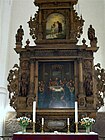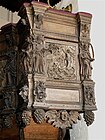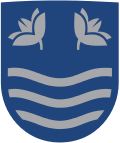
Assens is a town with a population of 6,001 on the west coast of the island of Funen on the eastern side of the Little Belt in central Denmark. By road, Assens is located 41.2 kilometres (25.6 mi) southwest of Odense, 34 kilometres (21 mi) northwest of Faaborg, and 33.34 kilometres (20.72 mi) southeast of Middelfart. Assens is the municipal seat of Assens Municipality in Region of Southern Denmark. It was the birthplace of sculptor Jens Adolf Jerichau who married the well-known portraitist Elisabeth Jerichau-Baumann; both artists' works are exhibited at the local art museum, Vestfyns Kunstmuseum.

The Church of Our Lady is the Lutheran cathedral of Copenhagen. It is situated on the Frue Plads public square in central Copenhagen, next to the historic main building of the University of Copenhagen.

Budolfi Church is the cathedral church for the Lutheran Diocese of Aalborg in north Jutland, Denmark.

The Holmen Church is a Parish church in central Copenhagen in Denmark, on the street called Holmens Kanal. First built as an anchor forge in 1563, it was converted into a naval church by Christian IV. It is famous for having hosted the wedding between Margrethe II of Denmark, queen of Denmark between 1972 and 2024, and Prince Henrik in 1967. It is the burial site of such notabilities as naval heroes Niels Juel and Peter Tordenskjold, and composer Niels Wilhelm Gade, and contains artwork by, among others, Bertel Thorvaldsen and Karel van Mander.

Our Lady's Priory, Aarhus was an early Dominican foundation just outside the original walls of Aarhus, Denmark. The buildings are part of the Church of Our Lady complex, now part of the inner city of Aarhus, but they have been repurposed.
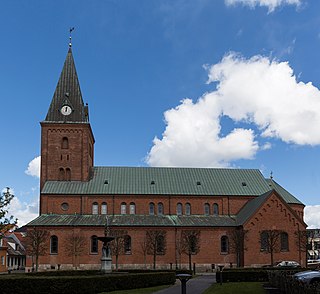
The Abbey of Our Lady, Aalborg was an early Benedictine monastery in Aalborg, Denmark. The former monastic church survived a parish church until 1876 when it was demolished. The present Vor Frue Kirke was built on the site between 1877 and 1878.

The Church of Our Lady is a historical building at Kalundborg in northwestern Zealand, Denmark. The precise date of construction is not known with any certainty, though its architecture indicates the early part of the 13th century. With its five distinctive towers, it stands on a hill above the harbour, making it the town's most imposing landmark.
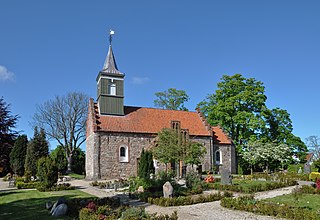
Nødebo Church is located in Nødebo in the northern part of the Danish island of Zealand. It is situated on the south-western shore of Lake Esrum, 5 km north of Hillerød and 40 km north of Copenhagen. The church is known for its church frescos and its early 16th century altarpiece.

Dankvart Dreyer was a Danish landscape painter of the Copenhagen School of painters who was educated under the guidance of Christoffer Wilhelm Eckersberg. Around 1840, he was part of the emerging National Romantic landscape painting scene in Denmark but as a result of his over-dramatic and excessively natural style, he did not fit the aesthetics and the ideology of the period. After being widely criticized, he turned his back on the artistic establishment and passed into near oblivion. In 1852, when only 36 years old, he died from typhus.

Vår Frue Church is a medieval parish church of the Church of Norway in Trondheim municipality in Trøndelag county, Norway. It is located in the downtown Midtbyen area of the city of Trondheim, just a few blocks north of the Nidaros Cathedral. It is one of the two churches for the Nidaros og Vår Frue parish which is part of the Nidaros domprosti (arch-deanery) in the Diocese of Nidaros. The gray, stone church was built in a long church design in the late 1100s using plans drawn up by Bjørn Sigvardsson. The church seats about 540 people.

St. Ib's Church, 3 km south-west of Svaneke on the Danish island of Bornholm, is a fine 12th century Romanesque building. The altarpiece was painted by Christoffer Wilhelm Eckersberg in 1846. The Renaissance pulpit was decorated by Paul Høm in 1964 with ceramics of the four evangelists.

St. Nicolas' Church with its distinctive tower is the parish church of Rønne on the island of Bornholm in the Diocese of Copenhagen. Enlarged and fully refurbished in 1918, it stands near the harbour on the site of an earlier church or chapel from the 13th century.

St. Canute's Church is a Romanesque church located 3 km northeast of Rønne on the Danish island of Bornholm.

Nexø Church is the parish church of Nexø, a port on the eastern coast of the Danish island of Bornholm.

Birket Church is located south of the little village of Birket, some 14 km (8.7 mi) northeast of Nakskov on the Danish island of Lolland. Its chancel was originally the nave of the brick Gothic church built in 1350. The bell tower, which stands apart from the church, is believed to be Denmark's oldest standing wooden structure.

The Old Church of Our Lady is an 11th-century brick church in Roskilde on the Danish island of Zealand.

Catholic Church of Our Lady is a church in Aarhus, Denmark. The church is situated in the central Indre By neighbourhood on the pedestrian street Ryesgade, close to the Central Station and City Hall. It is a Catholic Church within the Diocese of Copenhagen; built between 1877 and 1880 by designs of the German architect Franz Schmitz and later renovated by the architect Carl R. Frederiksen. The church has seating for 500 people.
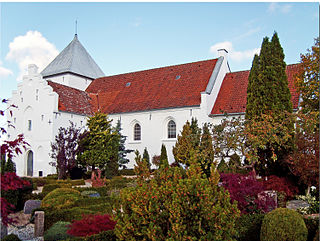
Kolt Church is a church located in Kolt Parish in Aarhus, Denmark. The church is situated in the Hasselager neighborhood, south-west of Viby. It is a parish church of the Church of Denmark and there's population of 6.973 within the parish borders (2016).

Saint Peter's Church is a Lutheran church located in the center of Slagelse, Denmark. The congregation was originally part of the Roman Catholic Church, but was converted to Lutheranism during the Reformation.





